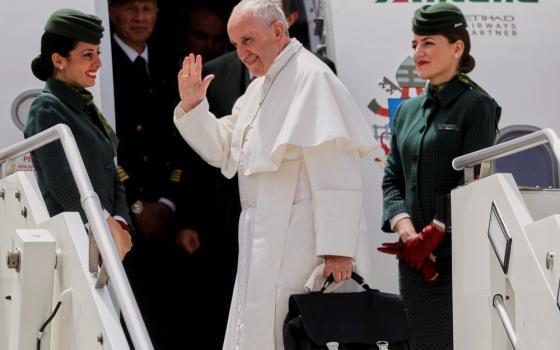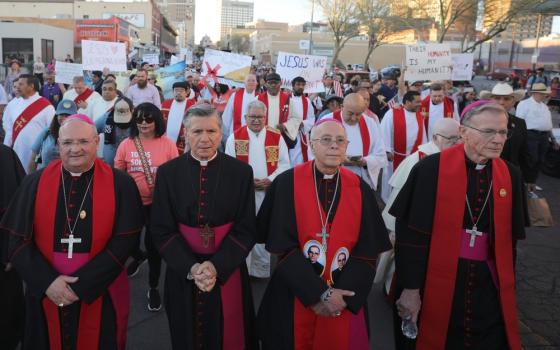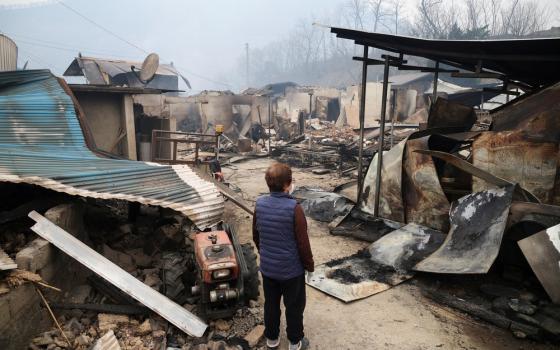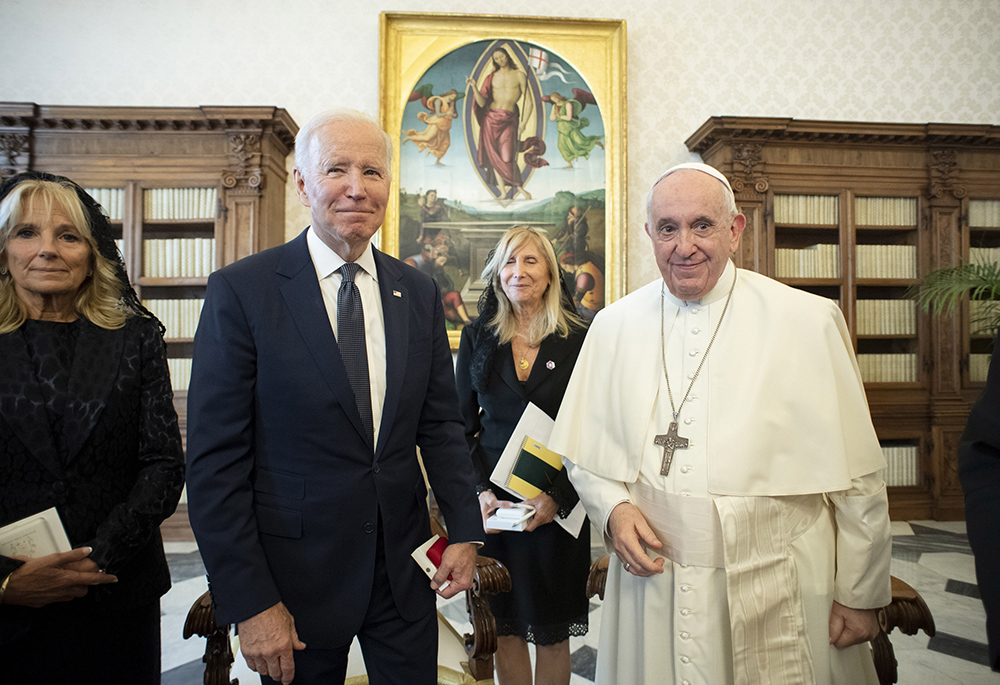
U.S. President Joe Biden, accompanied by his wife, Jill, is pictured with Pope Francis during a meeting at the Vatican Oct. 29, 2021. (CNS/Vatican Media)
When Pope Francis met U.S. President Joe Biden at the Vatican in October 2021, the president praised the pontiff as "the most significant warrior for peace I've ever met." Nearly three years later, as the two world leaders prepare to meet again on June 14, peace will very likely be the main topic of discussion, with the two men representing sharply different visions of what that requires in the present moment.
The first closely watched meeting between the two heads of state took place against the backdrop of a different kind of conflict, where certain U.S. bishops were battling to deny Communion to the nation's second Catholic president over his support for abortion rights. The pope — who told reporters ahead of that encounter that he had never denied the sacrament to anyone and warned against politicizing the Eucharist — seemed to want to send a clear signal where he landed on that debate.
In fact, after the pope-POTUS meeting, Biden told journalists that Francis had described him as a "good Catholic" during their private exchange and said that the regular Mass-going president should continue to receive Communion.
But as they meet for their second tête-à-tête of Biden's presidency — this time in southern Italy on the sidelines of the G7 Summit, where the pope will deliver a speech on artificial intelligence — it will be the two ongoing wars in Gaza and Ukraine that consume much of their conversation.
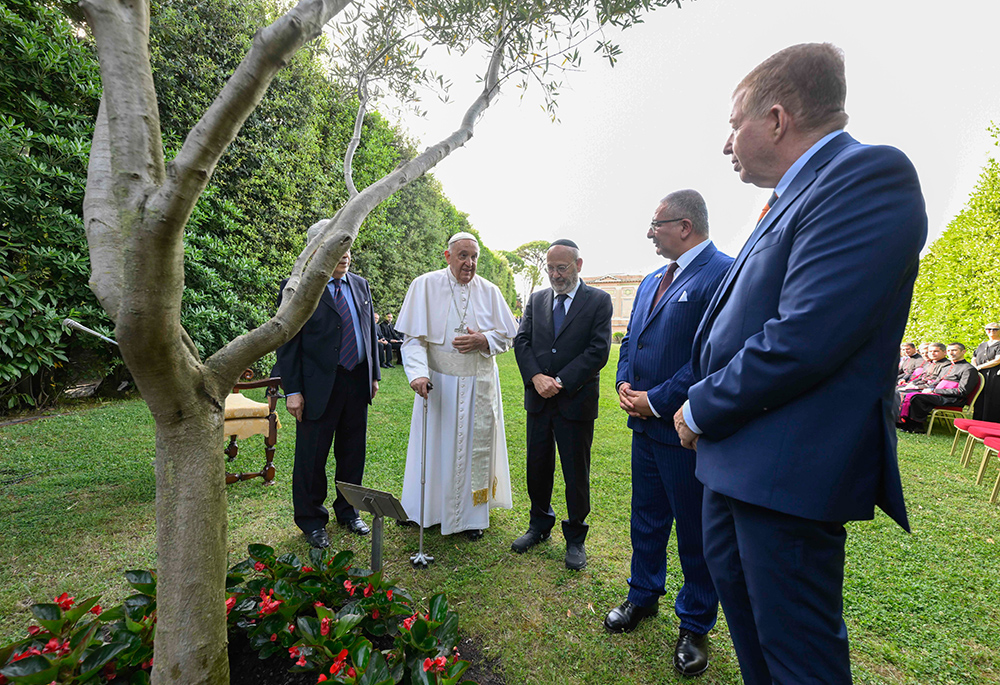
Pope Francis stands by an olive tree with Raphael Schutz, the Israeli ambassador to the Holy See, Issa Kassissieh, the Palestinian ambassador to the Holy See, Rabbi Alberto Funaro of Rome and Abdellah Redouane, secretary-general of Rome's Muslim community, June 7 in the Vatican Gardens. The tree was planted 10 years ago during a prayer service with Pope Francis, Orthodox Ecumenical Patriarch Bartholomew of Constantinople, Israeli President Shimon Peres and Palestinian President Mahmoud Abbas. (CNS/Vatican Media)
On one side will be a pope who has repeatedly called for a cease-fire in Gaza following Hamas' Oct. 7 attacks on Israel last year and who may or may not have referred to the siege of Gaza as a "genocide," depending on whose reports one believes. On the other side will be a U.S. president whose administration has continued to reaffirm its ironclad support of Israel, including the recent sale of more than $1 billion in arms, and who has balked at the notion of Israeli military conduct against Palestinians being compared to genocide.
Soon after the conflict began, it was the pope who called Biden in an effort to help lower the temperature in the Middle East and to help "identify paths to peace." Eight months later, as they speak again, it's unlikely that two sides will relitigate their different approaches to the events of the past year, but instead, seek to build momentum for new paths to peace, including possibly the recently formulated U.S.-backed plan for a cease-fire.
On Ukraine — where boosting support for the beleaguered country in its third year under siege from Russia is a top priority for the G7 agenda — there's even more distance between the two leaders.
Since the beginning of the conflict, a series of clumsy statements from Francis — from his suggestion that the conflict could be the result of NATO "barking" at the door of Russia to his more recent remarks that appeared to imply Ukraine should have the "courage of the white flag" to negotiate the war's end — have led to an uneasy relationship between the Holy See and much of the western world, including the United States.
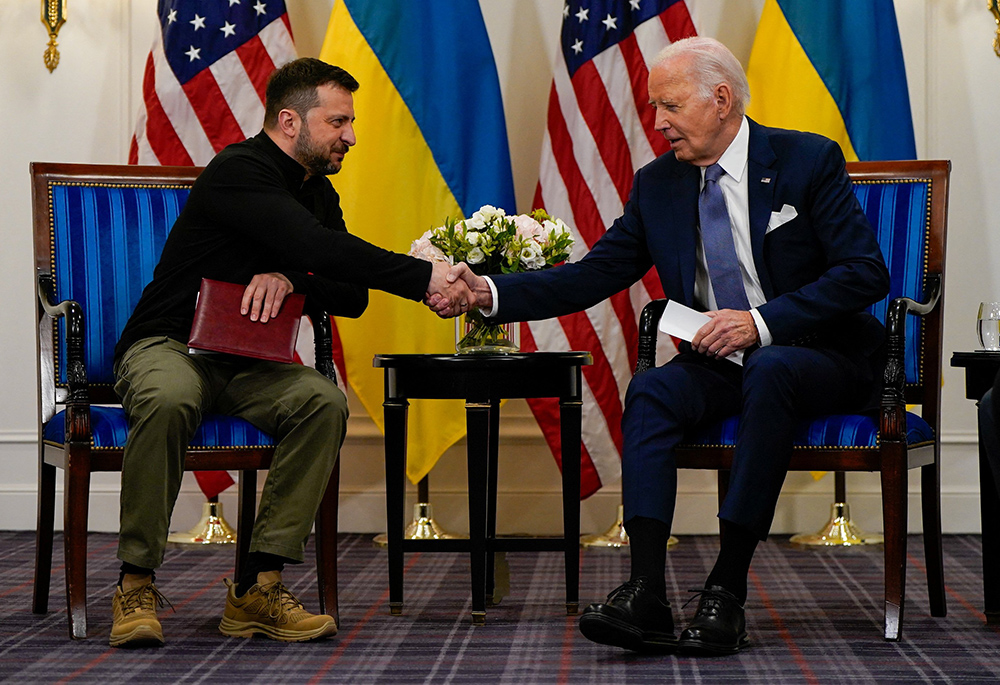
U.S. President Joe Biden shakes hands with Ukrainian President Volodymyr Zelenskyy June 7 in Paris, France. (OSV News/Reuters/Elizabeth Frantz)
With France, the United Kingdom and the United States giving Ukraine a greenlight to use their weapons to strike inside of Russia and a recent warning by the Vatican that such a move could lead to an "uncontrollable escalation" of the conflict, the differences between the Holy See and the United States — and their views on what's necessary to resolve the conflict in Ukraine — couldn't be starker.
Even so, when the pope and the president sit across from each other on Friday, the focus is likely to be on areas of convergence.
Most notably, expect much attention to be given to the joint effort between the pope's special peace envoy, Italian Cardinal Matteo Zuppi, and Biden's outgoing U.S. ambassador to the Vatican, Joe Donnelly, to repatriate an estimated 20,000 Ukrainian children abducted by Russia since the start of the war. Last July, the president held an Oval Office meeting with Zuppi and Donnelly to discuss the matter and this collaboration between the world's smallest state and the world's leading superpower might prove to be a useful off-ramp from dealing with other underlying tensions.
Back in July 2022, the Vatican's foreign minister, Archbishop Paul Gallagher, offered a candid assessment of the U.S.-Holy See relations, describing them as "very positive."
Advertisement
"Frankly speaking, I think we found that we didn’t see quite as eye-to-eye with the previous administration as we do with this one," said Gallagher. "Obviously, we have difficulties with this administration as well, which are well known. But at the same time, there are other issues on which we can work very well."
With a Biden-Trump rematch on the horizon — even with all that's happened since the last time the two men came face-to-face — both sides are probably making a similar calculation going into this upcoming meeting.
In 2021, the pope and the president met privately for more than 75 minutes inside the Vatican's Apostolic Palace for what is believed to be the longest meeting between Francis and any world leader. This time around — with the pope holding bilateral meetings with the other world leaders present at the G7 — strict time limits of 30 minutes have been set for their respective encounters.
But beyond geopolitics, there might be one other area where the pope and the president find common ground. At 81 years old, there's been no shortage of commentary on Biden's age and whether he's able to meet the demands of the job. Francis, at age 87, is already a year older than Biden would be at the end of a second term. And both men, despite some serious disagreements, are likely to be keen to channel a similar message, both to each other and to the world: Don't count us out yet.




